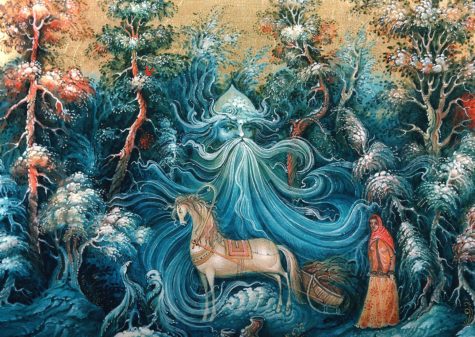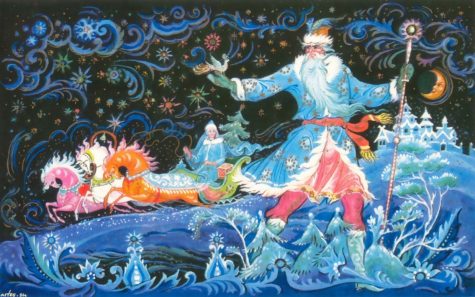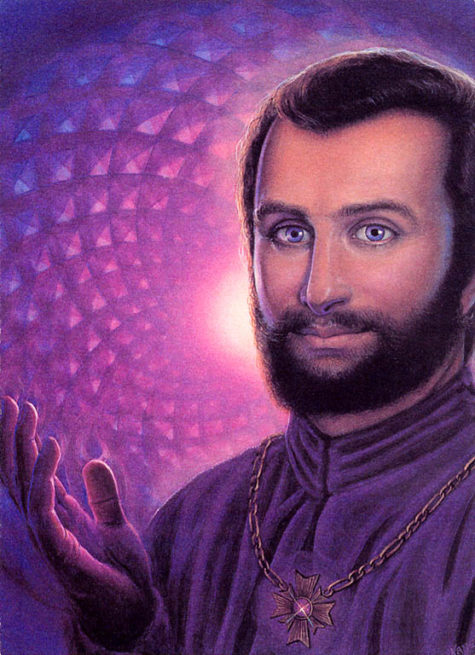Monthly Archives: December 2016
- Names: Father Frost
- Manifestation: Morozko signals his presence with the abrupt sound of ice cracking or trees snapping from the weight of snow.
- Attributes: An icy scepter; anyone who touches his scepter instantly falls asleep and will allegedly never awake.
- Daughter: Snegurochka – The Snow Queen.
Morozko is responsible for the ferocity of Russian winters. Whatever he touches with his staff instantly freezes. Morozko can raise or lower the temperature and cause snow to fall. Morozko is petitioned for snow and for safety from snow.
In a famous Russian fairy tale, a step-mother sends her step-daughter out into the forest at night, assuming that Morozko in the guise of freezing weather will kill the girl. Morozko does find the girl, but when he inquires whether she’s cold, the girl answers so politely and bravely that even his cold heart is touched.
Father Frost makes her a fire and sends her home with gifts the next morning.
The step-mother then sends her own daughter out into the woods at night, presuming that she’ll come home with valuable gifts, too. The spoiled girl whines and complains to Father Frost, who lets her freeze to death.
In 1966 the Russian film “Morozko” features a kinder, gentler Father Frost. He doesn’t kill the step-sister, only humiliates her.
Found in: The Encyclopedia of Spirits
Ded Moroz or Father Frost, the Slavic version of Santa Claus, long ago became the symbol of Russian winter, New Year’s and presents. He is usually accompanied by his granddaughter Snegurochka riding with an evergreen tree in a traditional Russian troika, a sleigh drawn by three horses abreast.
Ded Moroz is a Slavic fictional character similar to that of Father Christmas. The literal translation is “Old Man Frost”, often translated as “Grandfather Frost”. Ded Moroz brings presents to children and often delivers them in person on New Year’s Eve.
Ded Moroz is accompanied by Snegurochka the “Snow Maiden”, his granddaughter and helper, who wears long silver-blue robes and a furry cap or a snowflake-like crown. She is a unique attribute of Ded Moroz, since similar characters in other cultures don’t have a female companion.
The original Russian gift-giver was Saint Nicholas, the country’s Patron Saint, whose Feast Day is celebrated on December 6th. The image of Saint Nicholas originates from the image of another hero – the ancient Morozko. In Russian folklore Morozko is a powerful hero and smith who chains water with his “iron” frosts. Morozko was not hostile to people – he helped them and presented them with awesome presents.
In fairy tales Morozko is at times kind and at times evil. To be precise, he is kind towards the hard working and the good-hearted, but extremely severe with the mean and the lazy. And it is not about justice only. It is rather about two personalities living in one magical person.
Read more about Morozko here: Morozko
Ded Moroz and the Communists
In 1917, with the Bolshevik Revolution, Ded Moroz was banished into exile. He was considered a kind of a kids’ god, which was impermissible during Soviet times when Russian leaders were flatly against any manifestations of religiousness. But only 20 years later Ded Moroz returned to the country and New Year’s celebrations became public. Since then Ded Moroz and Snegurochka appear on New Year’s Eve, putting presents under the fir tree for the kids to find in the morning.
Visiting him at home
Those wishing to make acquaintance with Ded Moroz in his domestic surroundings can board trains and travel to the picturesque town of Veliky Ustyug in the Vologodsky Region of Northern Russia (approximately 500 miles northeast of Moscow) where, situated in the dense taiga forest at the confluence of three rivers, sits the log cabin of Ded Moroz.
There, in Veliky Ustyug, Ded Moroz waits through the summer reading letters that kids from all over the country have written to him regarding the presents they wish to find under the New Year’s Tree the next January 1st.
Characteristics
Ded Moroz has a number of distinguishing features. His shirt and trousers are made of flax and are usually decorated with white geometrical ornamental patterns. His fir coat is ankle long and is embroidered with silvery stars and crosses. His a semi-round fur hat is often red and embroidered with pearls. He has a long white beard.
Ded Moroz wears mittens and a wide white belt. His footwear is luxurious – high boots with silver ornamentation, but on an exceptionally chilly day Ded Moroz can opt for valenki!
And finally he never appears without his pikestaff – made either of silver or crystal, it possesses a twisted gripe. It helps the not-so-young Ded Moroz make his way through the deep dark forest during long winter nights.
Sources: Russiapedia and Wikipedia
Also known as: Comte de Saint Germain, The Count of Saint Germain, der Wundermann, Saint Germaine, The Wonderman of Europe
Helps with:
- Alchemy, Courage, Direction, Life Purpose, Miraculous Manifestations, Perseverance, Psychic Protection, Space Clearing
- Comfortably interacting with authority figures and influential people
Saint Germain is a loving, benevolent ascended master who wishes to work with lightworkers – that is, people who want to help the world clean up its act. He provides guidance, protection, and courage. He often works in conjunction with the Archangel Michael.
Invocation:
People don’t call Saint Germain, he’s the one who calls first. He seems to just show up wherever light workers are gathered in classes, study groups, or prayer meetings. He works with spiritual teachers to encourage their outgoing nature and leadership skills.
That’s not to say, however, that you can’t request a special audience with him when you desire a message or some type of motivation. Simply think, Saint Germain, I need your help. Wait a moment, and then mentally let him know the situation or question with which you need assistance.
You’ll know that he’s with you because a creative answer will come to you suddenly. You may also see violet-purple sparkles of light in the room. Or, you may start seeing violet-purple everywhere you go, on people’s clothing or on flowers, for instance. You’ll also begin thinking or writing profound thoughts on how to help others.
See also:
About Saint Germain:
Saint Germain isn’t a saint in the Catholic sense and shouldn’t be confused with “Saint Germaine Cousin” or “Saint Germanus,” two actual Catholic saints. Instead, he was a real man who was a royal count of the French region called “Saint Germain”
His real full name is Comte de Saint Germain, or The Count of Saint Germain. He was a man born of royal blood somewhere between 1690 and 1710, although reports conflict as to his parents’ lineage. Some say that his mother was Marie de Neubourg, the widow of King Charles II of Spain, and that his father was Comte Adanero. Others (particularly those associated with Theosophy) hold that his father was Prince Ragoczy of Transylvania. A few reports say that he was Prince Ragoczy. Still others claim he’s a Portuguese Jew.
It is believed by some that Sir Francis Bacon faked his own death on Easter Sunday, 9 April 1626, attended his own funeral and made his way from England to Transylvania where he found lodging in a castle owned by the Rakóczi family. There, on 1 May 1684, Bacon, by using alchemy, became an immortal occult master and adopted the name Saint Germain and became one of the Masters of the Ancient Wisdom, a group of beings that, Theosophists believe, form a Spiritual Hierarchy of planet Earth sometimes called the Ascended Masters. Thus, according to these beliefs, Saint Germain was a mysterious manifestation of the “resurrected form” (or “resurrection body”) of Sir Francis Bacon.
Some write that his name Saint Germain was invented by him as a French version of the Latin Sanctus Germanus, meaning “Holy Brother”. In the Ascended Master Teachings (but not in traditional Theosophy), the Master R, or the Master Rakóczi, also known as the Great Divine Director (a term introduced by Guy Ballard in the 1930s) is a separate and distinct being from Saint Germain – the Master Rakoczi is regarded in the Ascended Master Teachings as a name used by the Great Divine Director when he was functioning as Saint Germain’s teacher in the Great White Brotherhood of Ascended Masters.
Saint Germain, as one of the Masters of the Ancient Wisdom, is credited with near god-like powers and with longevity. Many groups honor Saint Germain as a supernatural being called a Master of the Ancient Wisdom or an Ascended master. In the Ascended Master Teachings he is referred to simply as Saint Germain, or as the Ascended Master Saint Germain. As an Ascended Master, Saint Germain is believed to have many magical powers such as the ability to teleport, levitate, walk through walls, and to inspire people by telepathy, among others.
Theosophists consider him to be a Mahatma, Masters of the Ancient Wisdom or Adept. Helena Blavatsky said that he was one of her Masters of Wisdom and hinted that he had given her secret documents. Some esoteric groups credit him with inspiring the Founding Fathers to draft the United States Declaration of Independence and the Constitution, as well as providing the design of the Great Seal of the United States.
In New Age beliefs, Saint Germain is always associated with the color violet, the jewel amethyst, and the Maltese cross rendered in violet (usually the iron cross style cross patee version). He is also regarded as the “Chohan of the Seventh Ray” According to Theosophy, the Seven Rays are seven metaphysical principles that govern both individual souls and the unfolding of each 2,158-year-long Astrological Age. Since according to Theosophy the next Astrological Age, the Age of Aquarius, will be governed by the Seventh (Violet) Ray (the Ray of Ceremonial Order), Saint Germain is sometimes called “The Hierarch of the Age of Aquarius”. According to the Ascended Master Teachings, Saint Germain is “The God of Freedom for this system of worlds.” According to the Ascended Master Teachings, the preliminary lead-up to the beginning of the Age of Aquarius began on 1 July 1956, when Ascended Master Saint Germain became the Hierarch of the Age of Aquarius, replacing the former Astrological Age Hierarch, the Ascended Master Jesus, who had been for almost 2,000 years the “Hierarch of the Age of Pisces”. Continue reading





